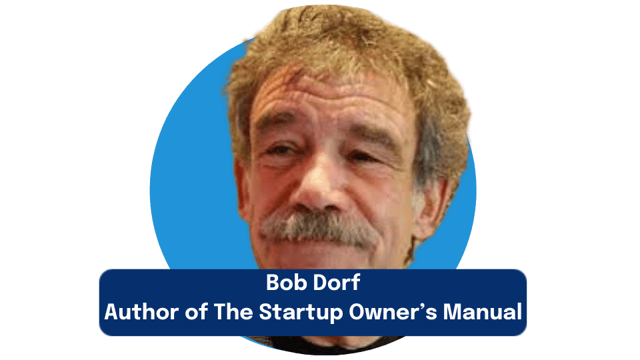No Bullsh*t Lean is Product Management

Bob Dorf, Author of The Startup Owner’s Manual, shares how product managers and the c-suite can embrace a culture of innovation and how companies can incentivize employees to take risks.
Bob Dorf started his first of seven startups 45 years ago when he was 22 years old. He’s also invested in or advised more than two dozen startups. After some successes (including 7 IPOs) and many failures, he co-wrote THE book on how to do a startup, The Startup Owner’s Manual, with Steve Blank.
Now, he helps some of the largest corporations in the world, including General Electric and Merck, achieve organic growth through Lean innovation.
In this episode, Bob shares the unique challenges of applying Lean methodology inside a large corporation and what senior executives and product managers can do to overcome them.
“Typically in big corporations, you bury the mistakes - you run from them - and you try very hard not to make them because big companies are all about execution. Lean, in the startup world, where the risk tolerance is infinitely higher, is all about getting it right and taking the risks and saying ‘oh that’ll never work, let’s try this’ and doing that over and over again until you get the right mix of value proposition, customer targeting, marketing, distribution to create a business that starts to thrive and grow.”
To achieve real growth (not just through cost cutting or M&A), Bob says corporations have to increase their tolerance for risk and take a trial and error approach, as opposed to simply executing a plan based on last year’s data. This is much easier for startups, who don’t have a history to rely on, than it is for large corporations, who have more restrictive operating procedures and incentive structures.
“If a corporation is going to strive for organic growth, through new divisions, new geographies, new customers, new products, it has the be comfortable enough and courageous enough to adopt the trial and error method and to operate in that search mode, which most big companies don’t like. They much prefer execution - where they can measure performance against revenue numbers, customer targets, attrition targets, marketing achievements, things like that, where you can put it all on a spreadsheet.”
Bob encourages executives to empower employees to take risks and bend the rules.
“It’s all about empowerment and permission to break rules. And the way I think of it is you almost have to put your Lean team in a bubble and protect them from the four feet of regulations and policies and procedures. Give them permission to, not put the company at risk, but to violate some of those rules.”
“When big companies do this successfully, they isolate the Lean team from the typical volumes of rule books that big companies have and give the team permission to fail. Hopefully they’re failing up by saying ‘that didn’t work, so let’s try this’, and sooner or later ‘this’ does work.”
Bob shares an example of a healthcare company he worked with that wasn’t allowed to talk to customers because of HIPAA compliance. Bob was prepared to tear up his contract and walk away. But the CEO was determined to find a solution and eventually they did: They never asked the customer his or her last name.
While this may all sound easy in theory, very few people are willing to take the career risk of starting or joining a startup team that has a high likelihood of failure. As Bob puts it: No one wants to give up their window cubicle to go move into a basement.
Bob shares two ways this challenge can be solved. The first is reward. The reward for a successful startup founder is obvious: wealth and fame. But large corporations can’t always offer stock or other financial incentives. Fortunately, they don’t need to. Employees are often motivated by career upside and exposure to senior leadership.
The second strategy Bob shares is to find an internal champion. “The Lean team has to have a passionate courageous champion”, he says. Despite the high rate of failure of new ideas - a much higher rate than large corporations are used to - executives need to focus on the upside.
“The biggest excuse is ‘we do everything by the book, we don’t fail and why would we take on that risk for some peanut of a business compared to our enterprise.’ But from that peanut grows a peanut farm and that’s really what the corporation needs to accept and strive for.”
Product managers and senior executives alike will learn a lot from this episode about how to practice Lean inside a large corporation. Here are the highlights:
- Lean is a movement that startups embrace but that goes against everything large companies stand for. Why should big companies care about Lean? (3:15)
- What are some of the ‘bullsh*t’ excuses stakeholders at large companies make to prevent this shift in mindset and practice? (6:45)
- How does Bob go about convincing the C-suite to change the processes that have been in place for decades? (18:05)
- How can leaders incentivize employees to innovate within their organizations? (25:00)

Subscribe now!
Get our new reports, case studies, podcasts, articles and events
